
The Great War in Europe once seemed so far away. True, even before the U.S. entered the war, some Americans had gone to Canada and volunteered to fight in the British forces, and others were serving in the war as nurses. But for most families, reality did not hit until June 5, 1917, when the war's first draft registration was held.
Nearly a year later, counting draftees as well as volunteers, more than 60 - the number kept increasing, so it was hard for people to be certain - residents of Hicksville were in uniform. The first U.S. soldiers had reached France, and their units were preparing for battle. More Americans troops arrived each week. It would not be long before reports of casualties became a regular feature of the local newspapers.
At home, there was something new: the service flag. The idea had started in Cleveland and then rapidly spread, both across the country and over the border into Canada.

The flags were simple enough to be made at home, although they could be bought in a store. They would be hung in the window of a house, or out front on a pole, so that everyone who passed by saw that someone from the home was in uniform: a man or woman (i.e., women could enlist in the Navy for non-combat duties, thus freeing male recruits for combat roles) was off somewhere serving the country. Each star - or in Canada, each maple leaf - on a service flag honored a different person.
Although the flags began as a grass roots movement, soon their use was regulated by state, and later by federal, government. People treated many of the rules (which varied from state to state) as mere guidelines, but most people respected the basic rule that a family could only display one star per serving member. That is, people who lived separately could not all fly service flags publicly to honor the same relative.
 There were communal flags, too, for businesses, schools, churches, etc. In October 1917, this flag with 40 blue stars hung outside the offices of the Brooklyn Eagle newspaper, in support of their employees who were then away in the service. Stars on different communal flags could signify the same person. For example, one young Hicksville man had worked for a bank before joining the Army. Thus, he was represented by a star on his bank's service flag, on his family's flag, and possibly on other flags as well.
There were communal flags, too, for businesses, schools, churches, etc. In October 1917, this flag with 40 blue stars hung outside the offices of the Brooklyn Eagle newspaper, in support of their employees who were then away in the service. Stars on different communal flags could signify the same person. For example, one young Hicksville man had worked for a bank before joining the Army. Thus, he was represented by a star on his bank's service flag, on his family's flag, and possibly on other flags as well.
In 1918, newspapers reported that Hicksville High School, like many other schools across the nation, was creating a service flag to honor its former students who were in the armed forces.
Judging by articles in the Eagle, the Jamaica Farmer, and the Long Islander, nearly every place on Long Island prominently displayed a town service flag, with blue stars for its residents who were in the services. Hicksville added itself to the list with great ceremony on the evening of April 26, 1918. The event coincided with the opening of the nation's Third Liberty Bond Drive of the war.
For those of us who may not remember after so many years, Liberty Bonds were savings bonds, sold in order to help finance the war effort.
That Friday at 7:00 P.M., the bells of the village's churches began to summon people to a parade. The marchers included cohorts of the State Police, the town Fire Department, and numerous service groups. There were 100 boys from St. John's Protectory, several hundred school children (each waving a small American flag), notable local citizens, a Miss Columbia, and a Miss Liberty. Six sturdy men together carried the Community Service Flag, unfurled for all to see. Sharp-eyed spectators could have counted 70 blue stars as the flag passed, one for each Hicksvillian in the military.
It is likely that many women carried little versions of their family service flags, put on sale specifically for this day's events, and available in a choice of fabrics:
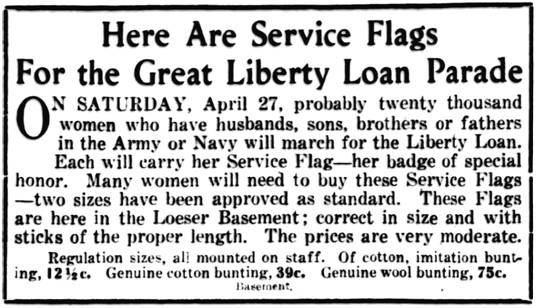
After winding its way through the core of the village, the parade ended at the corner of Broadway and Marie Street, in front of the new Huettner store building.

The photo shown below was the original Huettners on the corner of Broadway and Marie Street that eventually became Whelan Drugs. Huettners sales escalated and there was a need for the larger facility.

The ceremony began with an invocation by Rev. Robert Peterman of St. Stephen's Church; followed by the national anthem and stirring speeches. The service flag then was presented to Roscoe Craft, Principal of the School, who accepted it on behalf of the entire village.
Afterwards, Rev. Father Lawrence Fuchs, Dean of St. Ignatius Church, blessed the flag and addressed the crowd, which was estimated at 3,000.
More festivities followed, both inside the store and out, including music, dancing and a tea to raise funds for the Red Cross. The people of Hicksville, much motivated by the event, bought an astounding reported total of $70,000 of Liberty Bonds that night.
There would be more service flag ceremonies to attend that Spring, equally meaningful if not as grand. In May, St. Stephen's Church would dedicate its parish service flag, and the following month, there would be the dedication of the High School's flag.
 Throughout 1918, service flags were everywhere. Merchants stocked up on fabric for making them; they sold flag kits; they sold ready-made versions with 1, 2, or 3 stars. Printers advertised the special programs they could make for service flag dedications. Stores sold sheet music for service flags songs. People gathered together to sing them at homes, church socials, or anywhere there was a piano, and thought about absent loved ones as they sang. Or, they might purchase recordings, and play the songs on their hand-cranked phonographs.
Throughout 1918, service flags were everywhere. Merchants stocked up on fabric for making them; they sold flag kits; they sold ready-made versions with 1, 2, or 3 stars. Printers advertised the special programs they could make for service flag dedications. Stores sold sheet music for service flags songs. People gathered together to sing them at homes, church socials, or anywhere there was a piano, and thought about absent loved ones as they sang. Or, they might purchase recordings, and play the songs on their hand-cranked phonographs.
To the left is a cover for the sheet music of one of the many songs that were part of (cynics would later say, "that cashed in on") the public's appetite for service flags.
After a while, Hicksville's Community Service Flag was taken from its pole and re-hung, suspended from a cable stretched over Broadway, unfurled now so that its stars could always be seen. As time passed, the stars multiplied. In April, their number had seemed high for a village of fewer than 3,000 people, but it kept growing, until it finally reached 141. Each of those stars was echoed around town by a star on a flag displayed at a home, and perhaps on one in the School and/or a business. All these stars constituted Hicksville's part of the new galaxy of blue stars that were shining in all the nation's towns and cities.
That galaxy was about to start changing. Long dreaded, reports of casualties finally began to arrive. Given the war's chaos, the news was uncertain, often inconsistent, and usually very, very late. Americans began to think more deeply about their service flags.
In some places, women tried to announce with their flags that a son, brother, or husband had been wounded, sewing a red star over his blue one. That practice did not last long - as a group, Americans did not want their towns' windows dotted with red stars that were reminders of the blood being shed in Europe. In most places, it was agreed that a star would remain blue as long as the person it represented was alive.
Service flags, however, did not ignore deaths in the country's service. Deaths were acknowledged by having gold or yellow stars sewn over the blue ones. As the flag's white background did not contrast well with yellow, the new stars could be made smaller, leaving visible the edges of the blue stars to act as borders.
A few days after the Armistice, just as families were beginning to feel safe, Hicksville received news of its first war fatality. In the next four weeks, two similar reports arrived:
 Corporal Walter S. Wheeler, an electrician, had lived on Cherry Street. In France for barely a month, he had died of bronchial pneumonia on September 26th. The news had taken six weeks to reach his family.
Corporal Walter S. Wheeler, an electrician, had lived on Cherry Street. In France for barely a month, he had died of bronchial pneumonia on September 26th. The news had taken six weeks to reach his family.
 Sergeant Joseph A. Barry of William Street was sent overseas on the last day of July 1918. On November 3rd he succumbed to meningitis. Hicksville learned of his death at the end of that November.
Sergeant Joseph A. Barry of William Street was sent overseas on the last day of July 1918. On November 3rd he succumbed to meningitis. Hicksville learned of his death at the end of that November.
 Private Charles Wagner was wounded while under artillery fire, as he drove supplies to (or drove back from) the Front. He died of his wounds on October 2nd. News of his death did not reach home until two weeks before Christmas.
Private Charles Wagner was wounded while under artillery fire, as he drove supplies to (or drove back from) the Front. He died of his wounds on October 2nd. News of his death did not reach home until two weeks before Christmas.
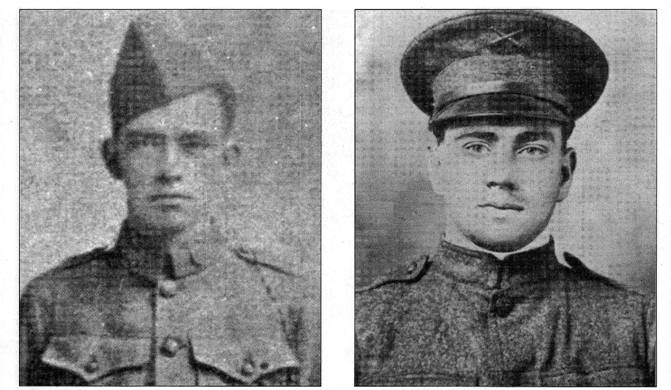
Joseph Barry Charles Wagner
Causes of Death for those lost in WW I sometimes are no longer recollected accurately. Those given here should be correct; they are per Soldiers of the Great War, published in 1920 by Soldiers Record Publishing Association. Where possible, the causes also were checked using the War Department's Abstracts of WW I Military Service in the N.Y. State Archives.
And so, the war already over, the village's Stars and Stripes was flown at half-mast three times, and three gold stars were added to Hicksville's service flag. On the next Memorial Day, three commemorative trees were planted near the flag pole.
July 4, 1919 was Hicksville's day to remember its heroes, to celebrate the Great War's outcome, and to try to start moving on. The morning began with a Victory Parade, filled with too many marvelous things and notable people (including Hicksville's two surviving Civil War veterans) to enumerate here. The Community Service Flag was displayed on a float in the parade. One hundred World War I veterans marched along their home town streets, as did two daughters of Hicksville who had served as Red Cross nurses. After the parade arrived at what by then had been named Depot Square, the boulder with its Honor Roll of names was unveiled and dedicated.
The Honor Roll and boulder were moved from the Square in 1947, to the grounds of what is now the Middle School.
The afternoon program included baseball at Cantiague Park and a concert in the square. Next was a dinner in the School auditorium for the returned veterans and their families. The evening ended with Block Dances at various spots around town.
Although Hicksville's service flags would be retired, new ones would appear during the second World War.

By the 1950s, interest in such flags had waned. If people wanted to show that loved ones were serving in the military, they then were more likely to use bumper stickers, or later, words on decals applied to their automobile's windows.
Today, the ribbon decal or sticker is the norm.
Epilogues
1
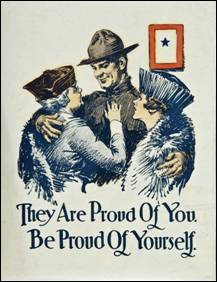
When America went to war, no one knew how many men it would need - or lose. Fearing rebuke by voters, the government drafted only as many as it dared, hoping to encourage as many voluntary enlistments as possible.
The service flag was an excellent way to do just that, for it offered the proverbial duo of carrot and stick. If patriotic appeal and family pride did not convince a man to recruit, public shaming (i.e., due to the absence of a blue star in his home's window) might get the job done. Sociologist Lisa M. Budreau offers a telling quote from a World War I mother: "In every home in this wide land is now a service flag, or explanations for the embarrassing lack of one."
2

The Wilson Administration worried about public reaction to casualties, fearing that morale might plummet as it had in Britain, where many mothers whose sons were coming of age now refused to let them enlist. There, apart from the elderly, the only men to be seen in the nation's streets were crippled returned veterans. Mourning women of all ages - who dressed head-to-toe in black, for a year or longer - were everywhere. Woodrow Wilson did not want to see his own country dappled with black.
In response, the government came up with the bold idea of changing long-standing cultural tradition. It encouraged American women to mourn their lost men by wearing white - while also wearing narrow black armbands that the government would provide. These were decorated with small, solitary embroidered stars fashioned of gold thread. The armbands were understated, inconspicuous, and they were official.
3
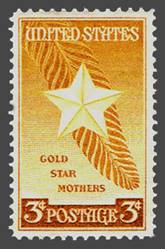
As American casualties continued, another new idea was forming. In Washington DC, Grace Siebold, mother of an American RAF pilot, had stopped hearing from him. Fearing he had been lost, she devoted many months of energy, frustration, and tears to trying to get news of him. Late in 1918, she learned that her fears had been warranted.
As she struggled with doubt, and then with the certainty of her son's death, she decided to honor his sacrifice by helping other mothers' sons—veterans who had survived the war, but who had returned home damaged, and in need. Word spread, and other grieving mothers followed her example. Their work led to the birth of a new organization, The Gold Star (a meaningful name for anyone who ever saw a service flag or a mother's armband). Now called the Gold Star Mothers, it remains dedicated to serving veterans left needful by their service in America's armed conflicts; its members still fly gold-star flags in their windows. They all had children who served in times of conflict and died as a result. In recent years, this has come to include deaths due to war-induced PTSD.
The last Sunday of each September is "Gold Star Mothers Day." In 1937, the Long Islander reported that on that day, Hicksville's Charles Wagner American Legion Post once again had honored the sacrifices of Mrs. Samuel Wheeler, Mrs. James Barry, and Mrs. Joseph Wagner.
Blue-star flags are flown today by members of Blue Star Mothers of America, a group formed during World War II. This photo of a home in Washington DC was taken in 2010.

photo by Djembayz, courtesy of WikiCommons
4
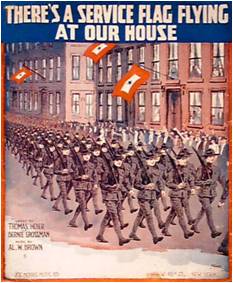
In conclusion, here is a song that tries to instill pride while still respecting those who must mourn (you can decide whether or not it succeeds). At the URL shown below, you can hear The Shannon Four perform "There's A Service Flag Flying At Our House."
https://www.youtube.com/watch?v=DIKD5NiZMRY
The following lines from the refrain, talking about a hypothetical son in the service, capture both the patriotic appeal and the emotional conflicts inherent in the use of wartime service flags:
Perhaps he may return to fame and glory
But if by chance we lose him in the fight
There'll be a Service Flag flying at our house
And a new star in Heav'n at night
****

unknown couple posing by window with WW I Service Flag

